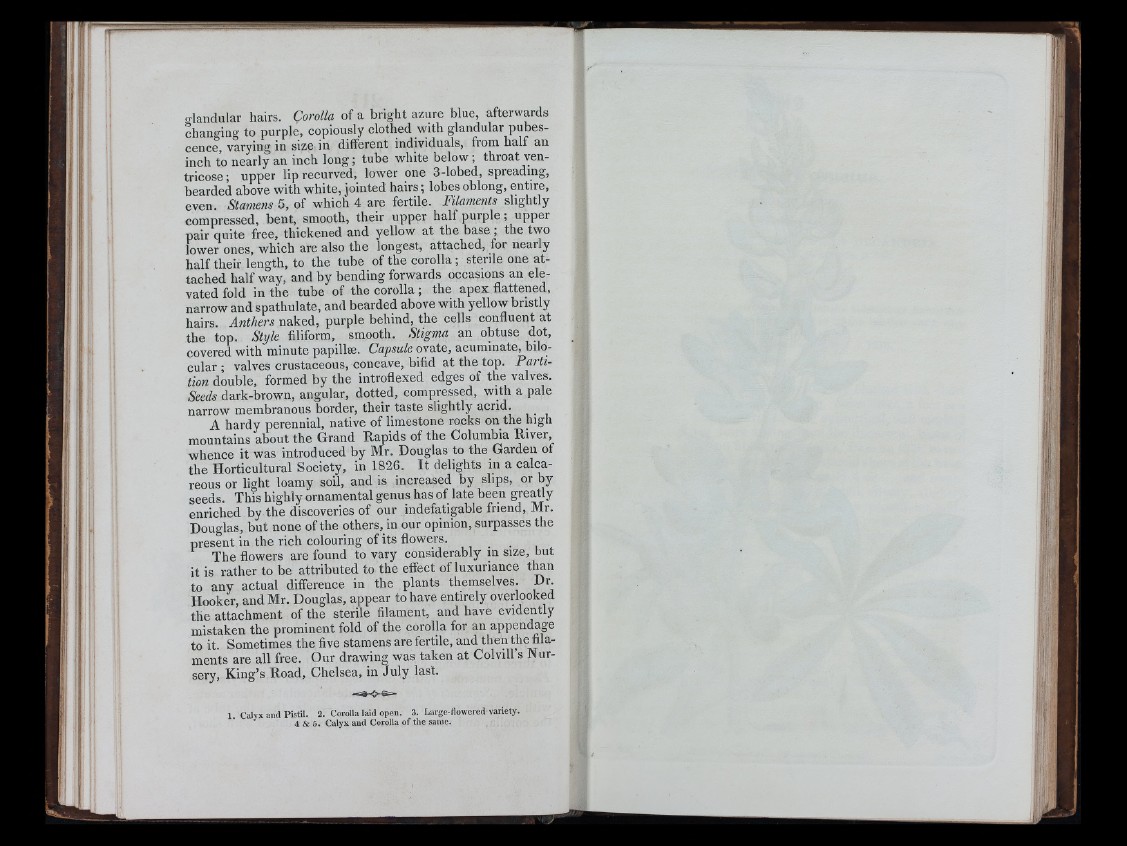
o-landular hairs. Corolla of a bright azure blue, afterwards
changing to purple, copiously clothed vvith glandular pubescence,
varying in size in different individuals, from half an
inch to nearly an inch long; tube white below; throat ventricose
; upper lip recurved, lower one 3-lobed, spreading,
bearded above with white, jointed hairs; lobes oblong, entire,
even. Stamens 5, of which 4 are fertile. Filaments slightly
compressed, bent, smooth, their upper half purple ¡ upper
pair quite free, thickened and yellow at the base ; the two
lower ones, which are also the longest, attached, for nearly
half their length, to the tube of the corolla ; sterile one attached
half way, and by bending forwards occasions an elevated
fold in the tube of the corolla ; the apex flattened,
narrow and spathulate, and bearded above with yellow bristly
hairs. Anthers naked, purple behind, the cells confluent at
the top. Style filiform, smooth. Stigma an obtuse dot,
covered with minute papillae. Capsule ovate, acuminate, bilo-
cular ; valves crustaceous, concave, bifid at the top. Partition
double, formed by the introflexed edges of the valves.
Seeds dark-brown, angular, dotted, compressed, with a pale
n a r ro w m em b r a n o u s b o rd e r, their taste s l ig h tly acrid.
A hardy perennial, native of limestone rocks on the high
mountains about the Grand Rapids of the Columbia River,
whence it was introduced by Mr. Douglas to the Garden of
the Horticultural Society, in 1826. I t delights in a calcareous
or light loamy soil, and is increased by slips, or by
seeds. This highly ornamental genus has of late been greatly
enriched by the discoveries of our indefatigable friend, Mr.
Douglas, but none of the others, in our opinion, surpasses the
present in the rich colouring of its flowers.
The flowers are found to vary considerably in size, hut
it is rather to be attributed to the effect of luxuriance than
to any actual difference in the plants themselves. Dr.
Hooker, and Mr. Douglas, appear to have entirely overlooked
the attachment of the sterile filament, and have evidently
mistaken the prominent fold of the corolla for an appendage
to it. Sometimes the five stamens are fertile, and then the filaments
are all free. Our drawing was taken at Colvill’s Nursery,
King’s Road, Chelsea, in July last.
1 Calyx and Pistil. 2. Corolla laid open. 3. Large-flowered variety.
4 & 5. Calyx and Corolla o f the same.